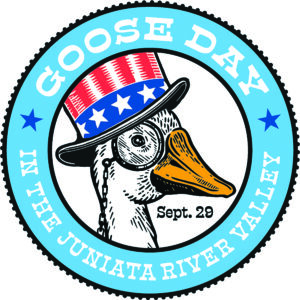How a local vet turned small-town cases into gripping suspense stories
LEWISTOWN — A cow stumbles in a muddy pen, steam rising in the Pennsylvania cold. Ron Erskine, boots caked with January slush, braces himself against the animal’s shoulder. A syringe dangles from his pocket.
The barn smells of sweet hay, diesel, and something sharper–old blood, animal fear, the kind of scent you remember but can’t quite name. Years before he put pen to paper, Erskine moved through these barns by instinct, stitching wounds, diagnosing fevers, trading quick hellos with Amish farmers who said little and watched everything. You can’t know you’re collecting stories until you look back and see how they stuck to you, the way manure sticks to boots and memory.
It matters because every small town has its stories, but not every town gets them written down. Not every vet finds the time or nerve to make fiction out of real pain and real people. On Tuesday, Sept. 23, Erskine returns to Mifflin County–his old stomping grounds–to tell the stories that, for years, simmered in the back of his mind.
His suspense novels, built from long nights and long odds, remind readers that the ordinary is never far from the extraordinary, and the line between the two often runs through a barnyard gate.
He didn’t set out to be a writer. He set out, as a suburban Chicago kid, to be a veterinarian, chasing James Herriot dreams in real American farmland. “I grew up in Cook County, Illinois, not a dairy farm within sight,” he remembers. His first taste of the world he would one day write about came as a college kid, working summers for large animal vets in Pennsylvania Dutch country. “It started appealing to me–these strange, large beasts,” he said, voice equal parts curiosity and awe.
Mifflin County in the early 1980s felt like its own country, a place where the calendar ran by planting and harvest, not the clock. “I remember driving up for an interview in Belleville and saying, Wow, could this be something new and different?”
The valley looked the same, he said, as it did decades before–small farms stitched between woods and ridge, people stubborn as rocks, and stories that unfolded at the pace of a horse-drawn buggy. You don’t learn the place overnight. You learn by listening, by tending to a sick cow at midnight, by keeping secrets for people who’d never
speak them out loud.
Suspense was never the plan. Memoir, maybe–Erskine had plenty of material. But what came out instead was something stranger and darker. “As one reviewer in Lansing said, well, it’s as if Stephen King helped James Herriot edit his books.” He laughs at the line. There’s truth in it. The books that followed–‘Casting Demons Into Swine,’ ‘Prometheus Scorned,’ ‘Ghosts of Lost Dreams’–wear their reality like a work shirt: patched, familiar, but layered with the supernatural and the what-if. “It drove me. While I was there, a series of events occurred, some of them catastrophic. The more I thought about them, the more I realized, if I just asked, ‘What if this happened instead?’ or put a little twist here.”
The rabies outbreak in the mid-80s, his first novel’s seed, needed little embellishment. “There was a mutation of a virus from a new variant in raccoons. By ’85, it had spread right up the mountains, hundreds of cases. Pennsylvania at the time was one of the last states not requiring rabies vaccination for dogs.”
He ran makeshift vaccine clinics in parking lots, working with local volunteers, charging five dollars a shot, trying to outrun the virus and bureaucracy. “We did nearly 700 animals that day on a cold January,” he said. “I was driving all over the county, to the shut-ins, the elderly people, and there was a lot of panic, a lot of fear.”
What matters, Erskine says, isn’t the catastrophe, but how a small community reacts. “What interested me more than anything else is how the community responded–this rural community, without a lot of resources, to some of these challenges. And the next thing you know, fiction is born.”
In his books, he fictionalizes the names. “I know I have farmers in mind as models for my characters, but I don’t make them exact,” and bends the stories, but the atmosphere is the same. A barn at night, a stranger at the door, a problem nobody’s seen before. In his hands, what’s real and what’s imagined blur. Readers catch themselves believing, then doubting, then believing again.
His protagonist–Dr. Malcolm Cromarty, his “proxy,” is no superhero. “There aren’t world-saving stakes. The world doesn’t depend on what happens in the valley during the rabies outbreak or a barn fire. But to me, it’s a very rich collection of everyday people. And again, how does this community respond?” Erskine’s own arc, over the four books, echoes Malcolm’s: new to the valley, out of place, learning to rely on others. “He has to rely on the barflies, the volunteer firefighters, the farm girl he gets in a romance with. He has to rely on everyday people to help navigate this.”
His stories are laced with things you can’t make up. Witchcraft, powwows, old-country remedies. “I use these cases to help the reader understand the Amish culture from a veterinarian’s standpoint. There’s more to the culture than I would have thought. I mean, imagine going to a farm for a yearling horse with a hernia, and the old gentleman’s disappointed because his egg powwow didn’t work. It must have been the hexing that went wrong. I’m like, pardon me?” He laughs, but there’s respect in it, the respect of someone who knows the power of a good story and the distance between fact and belief.
The transition to writer was difficult. “It took me 10 years to write the first book,” he admits. “I felt the people who knew me from the professional side–evidence-based investigator, science, research–wouldn’t take me seriously. All of a sudden, I’m supposed to be entertaining them.” The change took courage. “You feel like you’re exposing a side of yourself people might think isn’t genuine.” But he did it anyway, sentence by sentence, learning to pare back the clinical language, finding the music in the mundane, the darkness in the familiar. “I had to let that go, simplify some of the language, give enough of the veterinary cases so people know it’s genuine and yet not plow them over.”
Now he comes back to Mifflin County with stories in hand. At the library, he’ll read from the books, share genuine cases that inspired the fiction, and explain where he veered from fact and where he didn’t. There will be laughter, maybe a shiver or two, a lesson in Amish pharmacology, a glimpse of the valley’s old ghosts, a reminder that suspense doesn’t always need a big city or a big crime. Sometimes it finds you in the dark of a familiar barn, or in the memory of a frosty morning, or in the small space between what happened and what might have happened.
As the sun sets behind Jack’s Mountain and the last cars pull out of the library lot, Erskine’s stories will linger–a mix of animal breath, sweat, laughter, and fear. The stories that belong to a place and a people, written down by someone who lived them, dreamed them, and finally, let them out into the world.
You can purchase Erskine’s books on Amazon, his website at strayvoltagpress.com, or order them from local bookstores.


